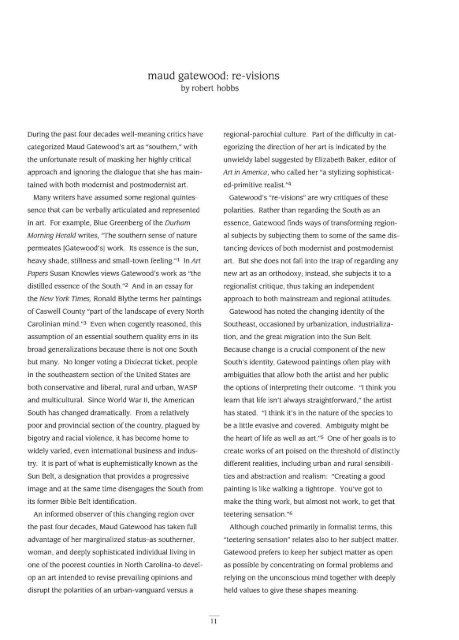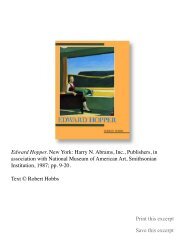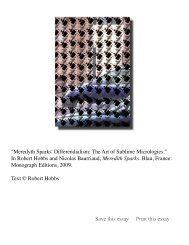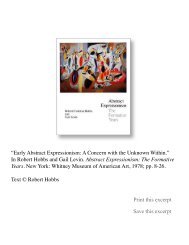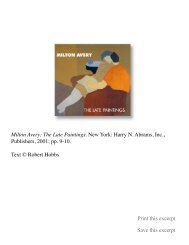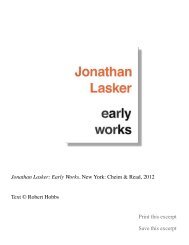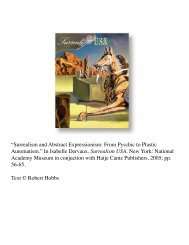Maud Gatewood: Re-Visions - Robert Hobbs
Maud Gatewood: Re-Visions - Robert Hobbs
Maud Gatewood: Re-Visions - Robert Hobbs
- No tags were found...
Create successful ePaper yourself
Turn your PDF publications into a flip-book with our unique Google optimized e-Paper software.
maud gatewood: re-visionsby robert hobbsDuring the past four decades well-meaning critics havecategorized <strong>Maud</strong> <strong>Gatewood</strong>'s art as "southern," withthe unfortunate result of masking her highly criticalapproach and ignoring the dialogue that she has maintainedwith both modernist and postmodernist art.Many writers have assumed some regional quintessencethat can be verbally articulated and representedin art. For example, Blue Greenberg of the DurhamMorning Herald writes, "The southern sense of naturepermeates [<strong>Gatewood</strong>'s] work. Its essence is the sun,heavy shade, stillness and small-town feeling.''' ln ArtPapers Susan Knowles views <strong>Gatewood</strong>'s work as "thedistilled essence of the South."2 And in an essay forthe New York Times, Ronald Blythe terms her paintingsof Caswell County "part of the landscape of every NorthCarolinian mind."3 Even when cogently reasoned, thisassumption of an essential southern quality errs in itsbroad generalizations because there is not one Southbut many. No longer voting a Dixiecrat ticket, peoplein the southeastern section of the United States areboth conservative and liberal, rural and urban, WASPand multicultural. Since World War II, the AmericanSouth has changed dramatically. From a relativelypoor and provincial section of the country, plagued bybigotry and racial violence, it has become home towidely varied, even international business and industry.It is part of what is euphemistically known as theSun Belt, a designation that provides a progressiveimage and at the same time disengages the South fromits former Bible Belt identification.An informed observer of this changing region overthe past four decades, <strong>Maud</strong> <strong>Gatewood</strong> has taken fulladvantage of her marginalized status-as southerner,woman, and deeply sophisticated individual living inone of the poorest counties in North Carolina-to developan art intended to revise prevailing opinions anddisrupt the polarities of an urban-vanguard versus aregional-parochial culture. Part of the difficulty in categorizingthe direction of her art is indicated by theunwieldy label suggested by Elizabeth Baker, editor ofArt in America, who called her "a stylizing sophisticated-primitiverealist. "4<strong>Gatewood</strong>'s "re-visions" are wry critiques of thesepolarities. Rather than regarding the South as anessence, <strong>Gatewood</strong> finds ways of transforming regionalsubjects by subjecting them to some of the same distancingdevices of both modernist and postmodernistart. But she does not fall into the trap of regarding anynew art as an orthodoxy; instead, she subjects it to aregionalist critique, thus taking an independentapproach to both mainstream and regional attitudes.<strong>Gatewood</strong> has noted the changing identity of theSoutheast, occasioned by urbanization, industrialization,and the great migration into the Sun Belt.Because change is a crucial component of the newSouth's identity, <strong>Gatewood</strong> paintings often play withambiguities that allow both the artist and her publicthe options of interpreting their outcome. "I think youlearn that life isn't always straightforward," the artisthas stated. "I think it's in the nature of the species tobe a little evasive and covered. Ambiguity might bethe heart of life as well as art. "S One of her goals is tocreate works of art poised on the threshold of distinctlydifferent realities, including urban and rural sensibilitiesand abstraction and realism : "Creating a goodpainting is like walking a tightrope. You've got tomake the thing work, but almost not work, to get thatteetering sensation ."6Although couched primarily in formalist terms, this"teetering sensation" relates also to her subject matter.<strong>Gatewood</strong> prefers to keep her subject matter as openas possible by concentrating on formal problems andrelying on the unconscious mind together with deeplyheld values to give these shapes meaning:II


